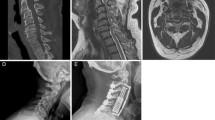Abstract
Dysphonia and dysphagia are common complications of anterior cervical discectomy (ACD). We sought to determine the relationship between dysphagia and in-hospital mortality, complications, speech therapy/dysphagia training, length of hospitalization, and costs associated with ACD. Discharge data from the Nationwide Inpatient Sample for 1,649,871 patients who underwent ACD of fewer than four vertebrae for benign acquired disease between 2001 and 2010 were analyzed using cross-tabulations and multivariate regression modeling. Dysphagia was reported in 32,922 cases (2.0 %). Speech therapy/dysphagia training was reported in less than 0.1 % of all cases and in only 0.2 % of patients with dysphagia. Dysphagia was significantly associated with age ≥65 years (OR = 1.5 [95 % CI 1.4–1.7], P < 0.001), advanced comorbidity (OR = 2.3 [2.0–2.6], P < 0.001), revision surgery (OR = 2.7 [2.3–3.1], P < 0.001), disc prosthesis placement (OR = 1.5 [1.0–2.0], P = 0.029), and vocal cord paralysis (OR = 11.6 [8.3–16.1], P < 0.001). Dysphagia was a significant predictor of aspiration pneumonia (OR = 8.6 [6.7–10.9], P < 0.001), tracheostomy (OR = 2.3 [1.6–3.3], P < 0.001), gastrostomy (OR = 30.9 [25.3–37.8], P < 0.001), and speech therapy/dysphagia training (OR = 32.0 [15.4–66.4], P < 0.001). Aspiration pneumonia was significantly associated with in-hospital mortality (OR = 15.9 [11.0–23.1], P < 0.001). Dysphagia, vocal cord paralysis, and aspiration pneumonia were significant predictors of increased length of hospitalization and hospital-related costs, with aspiration pneumonia having the single largest impact on length of hospitalization and costs. Dysphagia is significantly associated with increased morbidity, length of hospitalization, and hospital-related costs in ACD patients. Despite the known risk of dysphagia in ACD patients and an established role for the speech-language pathologist in dysphagia management, speech-language pathology intervention appears underutilized in this population.
Similar content being viewed by others
Reference
Daniels AH, Riew KD, Yoo JU, et al. Adverse events associated with anterior cervical spine surgery. J Am Acad Orthop Surg. 2008;16:729–38.
Fountas KN, Kapsalaki EZ, Nikolakakos LG, et al. Anterior cervical discectomy and fusion associated complications. Spine. 2007;32:2310–7.
Riley LH, Vaccaro AR, Dettori JR, Hashimoto R. Postoperative dysphagia in anterior cervical spine surgery. Spine. 2012;35(95):576–85.
Serra-Pratt M, Palomera M, Gomez C, et al. Oropharyngeal dysphagia as a risk factor for malnutrition and lower respiratory tract infection in independently living older persons: a population based prospective study. Age Aging. 2012;41(3):376–81.
Danto J, DiCapua J, Nardi D, et al. Multiple cervical levels: increased risk of dysphagia and dysphonia. J Neurosurg Anesthesiol. 2012;24(4):350–5.
Kalb S, Reis MT, Cowperthwaite MC, et al. Dysphagia after anterior cervical spine surgery: incidence and risk factors. World Neurosurg. 2012;77(1):183–7.
Foley NC, Martin RE, Salter KL, Teasell RW. A review of the relationship between dysphagia and malnutrition following stroke. J Rehabil Med. 2009;41:707–13.
Altman KW. Oropharyngeal dysphagia pathophysiology, complications, and science-based interventions. Nestle Nutr Inst Workshop Ser. 2012;72:119–26.
Plowman-Prine EK, Sapienza CM, Okun MS, et al. The relationship between quality of life and swallowing in Parkinson’s disease. Mov Disord. 2009;24(9):1352–8.
Chen PH, Golub JS, Hapner ER, Johns MM. Prevalence of perceived dysphagia and quality-of-life impairment in a geriatric population. Dysphagia. 2009;24(1):1–6.
Roy N, Stemple J, Merrill RM, Thomas L. Dysphagia in the elderly: preliminary evidence of prevalence, risk factors, and socioemotional effects. Ann Otol Rhinol Laryngol. 2007;116(11):858–65.
Cichero JA, Altman KW. Definition, prevalence, and burden of oropharyngeal dysphagia: a serious problem among older adults worldwide and the impact on prognosis and hospital resources. Nestle Nutr Inst Workshop Ser. 2012;72:1–11.
Alvarez-Hernandez J. Planas Vila M, Leon-Sanz M et al. Prevalence and costs of malnutrition in hospitalized patients: the PREDyCES study. Nutr Hosp. 2012;27(4):1049–59.
Semenov YR, Starmer HM, Gourin CG. The effect of pneumonia on short-term outcomes and cost of care after head and neck cancer surgery. Laryngoscope. 2012;122(9):1994–2004.
Overview of the Nationwide Inpatient Sample. Available at http://www.hcup-us.ahrq.gov/nisoverview.jsp Accessed 1 Oct 2012.
Liu JH, Zingmond DS, McGory ML, et al. Disparities in the utilization of high-volume hospitals for complex surgery. JAMA. 2006;296:1973–80.
Charlson ME, Pompei P, Ales KL, MacKenzie CR. A new method of classifying prognostic comorbidity in longitudinal studies: development and validation. J Chron Dis. 1987;40:373–83.
Romano P, Roos LL, Jollis JG. Adapting a clinical comorbidity index for use with ICD-9-CM administrative data: differing perspectives. J Clin Epidemiol. 1993;46:1075–9.
Cost-to-Charge Ratio Files. Available at www.hcup-us.ahrq.gov/db/state/costtocharge.jsp Accessed 20 Aug 2012.
Newhouse RP, Mills ME, Johantgen M, Provonost PJ. Is there a relationship between service integration and differentiation and patient outcomes? Int J Integrated Care. 2003;3:1–13.
U.S. Department of Labor, Bureau of Labor Statistics, Consumer Price Index Inflation Calculator. Available at http://www.bls.gov/bls/inflation.htm Accessed 20 Aug 2012.
Carnaby G, Hankey GJ, Pizzi J. Behavioral intervention for dysphagia in acute stroke: a randomized controlled trial. Lancet Neurol. 2006;5:31–7.
Kilburg C, Sullivan HG, Mathiason MA. Effect of approach side during anterior cervical discectomy and fusion on the incidence of recurrent laryngeal nerve injury. J Neurosurg Spine. 2006;4(4):273–7.
Morpeth JF, Williams MF. Vocal fold paralysis after anterior cervical diskectomy and fusion. Laryngoscope. 2000;110(1):43–6.
Conflict of interest
The authors have no conflicts of interest to disclose
Author information
Authors and Affiliations
Corresponding author
Rights and permissions
About this article
Cite this article
Starmer, H.M., Riley, L.H., Hillel, A.T. et al. Dysphagia, Short-Term Outcomes, and Cost of Care After Anterior Cervical Disc Surgery. Dysphagia 29, 68–77 (2014). https://doi.org/10.1007/s00455-013-9482-9
Received:
Accepted:
Published:
Issue Date:
DOI: https://doi.org/10.1007/s00455-013-9482-9




